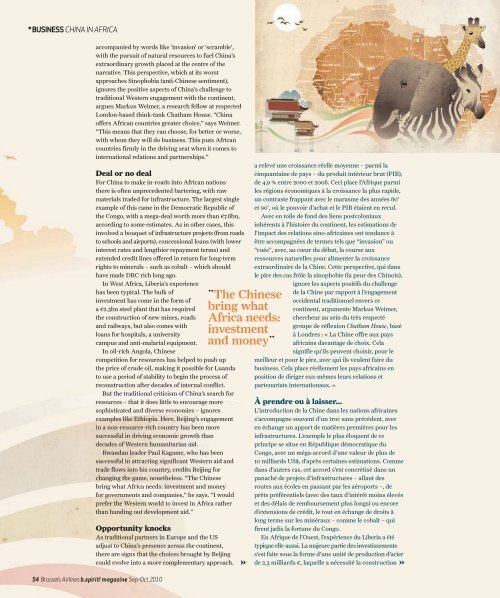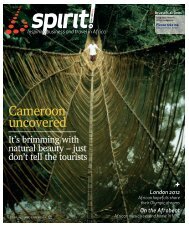september-2010
september-2010
september-2010
Create successful ePaper yourself
Turn your PDF publications into a flip-book with our unique Google optimized e-Paper software.
* BUSINESS CHINA IN AFRICA<br />
accompanied by words like ‘invasion’ or ‘scramble’,<br />
with the pursuit of natural resources to fuel China’s<br />
extraordinary growth placed at the centre of the<br />
narrative. This perspective, which at its worst<br />
approaches Sinophobia (anti-Chinese sentiment),<br />
ignores the positive aspects of China’s challenge to<br />
traditional Western engagement with the continent,<br />
argues Markus Weimer, a research fellow at respected<br />
London-based think-tank Chatham House. “China<br />
offers African countries greater choice,” says Weimer.<br />
“This means that they can choose, for better or worse,<br />
with whom they will do business. This puts African<br />
countries firmly in the driving seat when it comes to<br />
international relations and partnerships.”<br />
Deal or no deal<br />
For China to make in-roads into African nations<br />
there is often unprecedented bartering, with raw<br />
materials traded for infrastructure. The largest single<br />
example of this came in the Democratic Republic of<br />
the Congo, with a mega-deal worth more than €7.8bn,<br />
according to some estimates. As in other cases, this<br />
involved a bouquet of infrastructure projects (from roads<br />
to schools and airports), concessional loans (with lower<br />
interest rates and lengthier repayment terms) and<br />
extended credit lines offered in return for long-term<br />
rights to minerals – such as cobalt – which should<br />
have made DRC rich long ago.<br />
In West Africa, Liberia’s experience<br />
has been typical. The bulk of<br />
investment has come in the form of<br />
a €2.3bn steel plant that has required<br />
the construction of new mines, roads<br />
and railways, but also comes with<br />
loans for hospitals, a university<br />
campus and anti-malarial equipment.<br />
In oil-rich Angola, Chinese<br />
competition for resources has helped to push up<br />
the price of crude oil, making it possible for Luanda<br />
to use a period of stability to begin the process of<br />
reconstruction after decades of internal conflict.<br />
But the traditional criticism of China’s search for<br />
resources – that it does little to encourage more<br />
sophisticated and diverse economies – ignores<br />
examples like Ethiopia. Here, Beijing’s engagement<br />
in a non-resource-rich country has been more<br />
successful in driving economic growth than<br />
decades of Western humanitarian aid.<br />
Rwandan leader Paul Kagame, who has been<br />
successful in attracting significant Western aid and<br />
trade flows into his country, credits Beijing for<br />
changing the game, nonetheless. “The Chinese<br />
bring what Africa needs: investment and money<br />
for governments and companies,” he says. “I would<br />
prefer the Western world to invest in Africa rather<br />
than handing out development aid.”<br />
Opportunity knocks<br />
As traditional partners in Europe and the US<br />
adjust to China’s presence across the continent,<br />
there are signs that the choices brought by Beijing<br />
could evolve into a more complementary approach.<br />
54 Brussels Airlines b.spirit! magazine Sep-Oct <strong>2010</strong><br />
¨The Chinese<br />
bring what<br />
Africa needs:<br />
investment<br />
and money¨<br />
a relevé une croissance réelle moyenne – parmi la<br />
cinquantaine de pays – du produit intérieur brut (PIB),<br />
de 4,9 % entre 2000 et 2008. Ceci place l’Afrique parmi<br />
les régions économiques à la croissance la plus rapide,<br />
un contraste frappant avec le marasme des années 80’<br />
et 90’, où le pouvoir d’achat et le PIB étaient en recul.<br />
Avec en toile de fond des liens postcoloniaux<br />
inhérents à l’histoire du continent, les estimations de<br />
l’impact des relations sino-africaines ont tendance à<br />
être accompagnées de termes tels que “invasion” ou<br />
“ruée”, avec, au cœur du débat, la course aux<br />
ressources naturelles pour alimenter la croissance<br />
extraordinaire de la Chine. Cette perspective, qui dans<br />
le pire des cas frôle la sinophobie (la peur des Chinois),<br />
ignore les aspects positifs du challenge<br />
de la Chine par rapport à l’engagement<br />
occidental traditionnel envers ce<br />
continent, argumente Markus Weimer,<br />
chercheur au sein du très respecté<br />
groupe de réflexion Chatham House, basé<br />
à Londres : « La Chine offre aux pays<br />
africains davantage de choix. Cela<br />
signifie qu’ils peuvent choisir, pour le<br />
meilleur et pour le pire, avec qui ils veulent faire du<br />
business. Cela place réellement les pays africains en<br />
position de diriger eux-mêmes leurs relations et<br />
partenariats internationaux. »<br />
À prendre ou à laisser…<br />
L’introduction de la Chine dans les nations africaines<br />
s’accompagne souvent d’un troc sans précédent, avec<br />
en échange un apport de matières premières pour les<br />
infrastructures. L’exemple le plus éloquent de ce<br />
principe se situe en République démocratique du<br />
Congo, avec un méga-accord d’une valeur de plus de<br />
10 milliards US$, d’après certaines estimations. Comme<br />
dans d’autres cas, cet accord s’est concrétisé dans un<br />
panaché de projets d’infrastructures – allant des<br />
routes aux écoles en passant par les aéroports –, de<br />
prêts préférentiels (avec des taux d’intérêt moins élevés<br />
et des délais de remboursement plus longs) ou encore<br />
d’extensions de crédit, le tout en échange de droits à<br />
long terme sur les minéraux – comme le cobalt – qui<br />
firent jadis la fortune du Congo.<br />
En Afrique de l’Ouest, l’expérience du Liberia a été<br />
typique elle-aussi. La majeure partie des investissements<br />
s’est faite sous la forme d’une unité de production d’acier<br />
de 2,3 milliards €, laquelle a nécessité la construction











